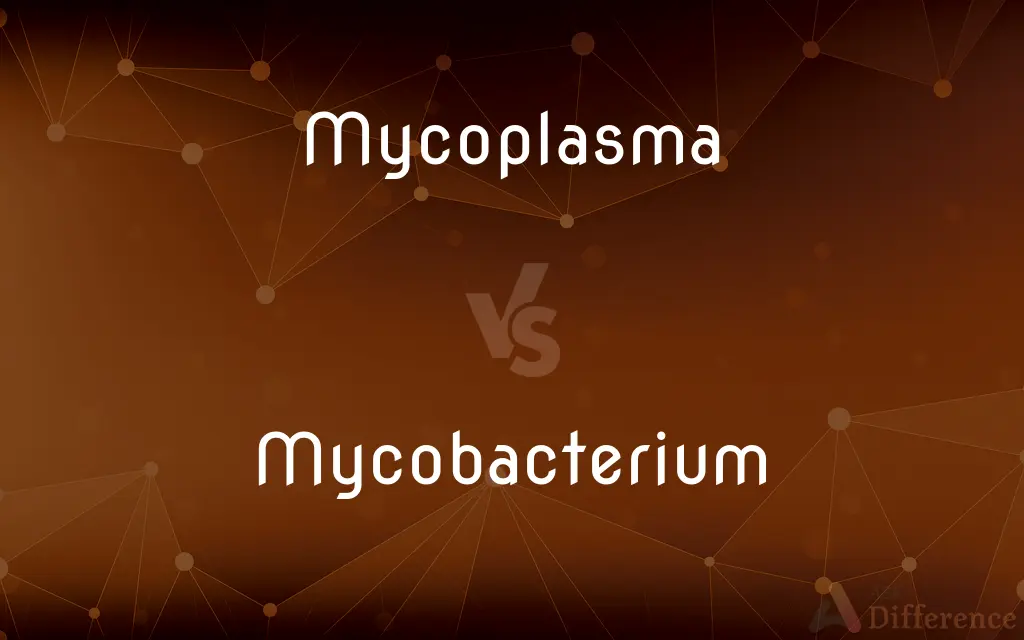Mycoplasma vs. Mycobacterium — What's the Difference?
Edited by Tayyaba Rehman — By Fiza Rafique — Updated on October 27, 2023
Mycoplasma are small bacteria without a cell wall, causing respiratory and urogenital infections, while Mycobacterium are rod-shaped bacteria with a unique cell wall, causing diseases like tuberculosis.

Difference Between Mycoplasma and Mycobacterium
Table of Contents
ADVERTISEMENT
Key Differences
Mycoplasma and Mycobacterium, while both bacteria, differ significantly in their structure and the diseases they cause. Mycoplasma, known for its lack of a cell wall, occupies a unique niche in the bacterial world, rendering them resistant to many antibiotics that target cell wall synthesis. On the other hand, Mycobacterium, possessing a distinct and waxy cell wall, makes them resistant to many common stains and gives them their unique characteristic of being acid-fast.
Mycoplasma is often associated with infections in the respiratory and urogenital tracts. They are the smallest self-replicating organisms and can take various shapes due to the absence of a rigid cell wall. Mycobacterium, however, is notorious for causing severe diseases like tuberculosis and leprosy. These bacteria are rod-shaped and can survive in harsh environments due to their robust cell wall.
For researchers and medical professionals, differentiating between Mycoplasma and Mycobacterium is crucial. Mycoplasma contamination can be a significant concern in cell culture, impacting research results. Mycobacterium, with its slow growth and specific culture requirements, needs specialized laboratory techniques for identification and diagnosis.
Both Mycoplasma and Mycobacterium hold clinical significance. While Mycoplasma pneumoniae can lead to walking pneumonia, Mycobacterium tuberculosis is responsible for the vast majority of tuberculosis cases worldwide. As pathogens, understanding their biology and pathology is essential for diagnosis, treatment, and prevention.
Comparison Chart
Cell Wall
Lacks a cell wall
Unique, waxy cell wall
ADVERTISEMENT
Shape
Can take various shapes
Rod-shaped
Diseases
Respiratory and urogenital infections
Tuberculosis, leprosy
Resistance
Resistant to antibiotics targeting cell wall synthesis
Resistant to many common stains (acid-fast)
Examples
Mycoplasma pneumoniae
Mycobacterium tuberculosis
Compare with Definitions
Mycoplasma
Can take on various shapes.
The absence of a rigid cell wall lets Mycoplasma morph into different shapes.
Mycobacterium
Known for being acid-fast in staining.
The Ziehl-Neelsen stain identifies Mycobacterium due to its acid-fast property.
Mycoplasma
Smallest self-replicating organisms.
The small size of Mycoplasma allows it to pass through many bacterial filters.
Mycobacterium
Can survive in harsh environments.
The robust cell wall of Mycobacterium allows it to persist in challenging conditions.
Mycoplasma
Small bacteria lacking a cell wall.
Mycoplasma infections can be challenging to treat due to their lack of a cell wall.
Mycobacterium
Rod-shaped bacteria with a unique cell wall.
Mycobacterium's cell wall makes them resistant to certain staining methods.
Mycoplasma
Causes respiratory and urogenital infections.
Mycoplasma pneumoniae is a common cause of walking pneumonia.
Mycobacterium
Causes diseases like tuberculosis and leprosy.
Mycobacterium tuberculosis is a leading cause of death worldwide.
Mycoplasma
Common contaminant in cell cultures.
Researchers must check cell cultures for Mycoplasma contamination regularly.
Mycobacterium
Mycobacterium is a genus of Actinobacteria, given its own family, the Mycobacteriaceae. Over 190 species are recognized in this genus.
Mycoplasma
Mycoplasma (plural mycoplasmas or mycoplasmata) is a genus of bacteria that lack a cell wall around their cell membranes. This characteristic makes them naturally resistant to antibiotics that target cell wall synthesis (like the beta-lactam antibiotics).
Mycobacterium
Any of various rod-shaped, aerobic, often pathogenic bacteria of the genus Mycobacterium, including the causative agents of tuberculosis and leprosy.
Mycoplasma
Any of a group of small typically parasitic bacteria that lack cell walls and sometimes cause diseases.
Mycobacterium
(bacteriology) Any of many rod-shaped, aerobic bacteria, of the genus Mycobacterium, that cause diseases such as tuberculosis and leprosy.
Mycoplasma
Any of various extremely small bacteria of the genus Mycoplasma that lack cell walls, are usually nonmotile, and are often pathogenic or parasitic in mammals.
Mycobacterium
Any of various rod-shaped bacteria, some saprophytic or causing diseases.
Mycoplasma
Any infectious bacterium of the genus Mycoplasma, often specifically Mycoplasma pneumoniae
Mycobacterium
Rod-shaped bacteria some saprophytic or causing diseases
Mycoplasma
The smallest self-reproducing prokaryote; lacks a cell wall and can survive without oxygen; can cause pneumonia and urinary tract infection
Mycobacterium
Requires specialized lab techniques for diagnosis.
Identifying Mycobacterium in clinical samples often demands specific culture methods.
Common Curiosities
Are Mycoplasma infections easily treatable with common antibiotics?
No, many antibiotics target the cell wall, so they're ineffective against Mycoplasma.
Which organism is smaller in size?
Mycoplasma is among the smallest self-replicating organisms.
Why is Mycobacterium termed "acid-fast"?
Mycobacterium's waxy cell wall retains certain stains even when washed with acid, making them "acid-fast."
Is leprosy caused by a type of Mycobacterium?
Yes, leprosy is caused by Mycobacterium leprae.
Are there vaccines for diseases caused by Mycobacterium?
Yes, the BCG vaccine is used against tuberculosis, caused by Mycobacterium tuberculosis.
Can Mycoplasma cause pneumonia?
Yes, specifically, Mycoplasma pneumoniae can lead to walking pneumonia.
What disease is commonly caused by Mycobacterium?
Tuberculosis is a common disease caused by Mycobacterium tuberculosis.
Are Mycoplasma infections always harmful?
Not always. Some Mycoplasma species live harmlessly in hosts, but others can cause disease.
Do Mycoplasma have a cell wall?
No, Mycoplasma lack a cell wall.
How do Mycoplasma affect cell culture research?
Mycoplasma contamination can alter cell functions and invalidate research results.
Are Mycoplasma and Mycobacterium related?
While both are bacteria, they belong to different families and have distinct characteristics.
What makes Mycobacterium resistant to certain stains?
Their unique, waxy cell wall doesn't absorb many common stains but retains specific ones.
How are Mycobacterium infections diagnosed?
Specialized lab techniques, including acid-fast staining and specific culture methods, are used.
Share Your Discovery

Previous Comparison
Tabloid vs. Broadsheet
Next Comparison
Agility vs. DexterityAuthor Spotlight
Written by
Fiza RafiqueFiza Rafique is a skilled content writer at AskDifference.com, where she meticulously refines and enhances written pieces. Drawing from her vast editorial expertise, Fiza ensures clarity, accuracy, and precision in every article. Passionate about language, she continually seeks to elevate the quality of content for readers worldwide.
Edited by
Tayyaba RehmanTayyaba Rehman is a distinguished writer, currently serving as a primary contributor to askdifference.com. As a researcher in semantics and etymology, Tayyaba's passion for the complexity of languages and their distinctions has found a perfect home on the platform. Tayyaba delves into the intricacies of language, distinguishing between commonly confused words and phrases, thereby providing clarity for readers worldwide.
















































